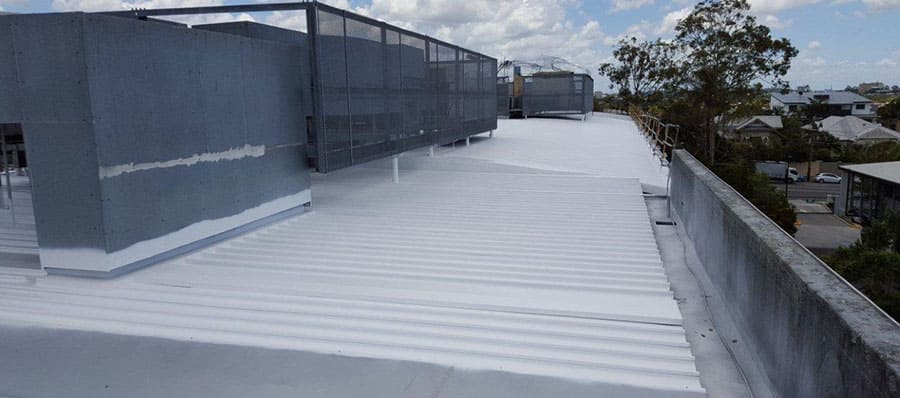
Types of Waterproofing Methods
Ideally, a waterproofing should be strong, flexible, tear-resistant and elastic so that it can stretch to cover cracks and also move with the building. If the membrane is to be exposed to the sun, then it should be UV stable. The membrane should be flexible enough to take any shape it is laid over, and be capable of turning up and over walls and other construction features.
The following waterproofing methods are commonly used in construction:
- Cementitious Waterproofing
- Liquid Waterproofing Membrane
- Bituminous Membrane
- Bituminous Coating
- Polyurethane Liquid Membrane
1. Cementitious Waterproofing Method

Cementitious waterproofing is the easiest method of waterproofing in construction. The materials for cementitious waterproofing is easily available from suppliers of masonry products, and they’re easy to mix and apply.
This method is often used in the internal wet areas such as toilets. This method is usually a rigid or semi-flexible type waterproofing, but since it is used in internal areas such as toilets, it is not exposed to sunlight and weathering. Thus cementitious waterproofing does not go through contract and expansion process.
Applications of Cementitious Waterproofing
Cementitious waterproofing is used in the following type of structures:
- Water Treatment Plants
- Sewage Treatment Plants
- Bridges
- Dams
- Railway & Subway Systems
- Marine Cargo Ports & Docks
- River Locks/Channels & Concrete Dykes
- Parking Structures & Lots
- Tunnels
2. Liquid Waterproofing Membrane Method
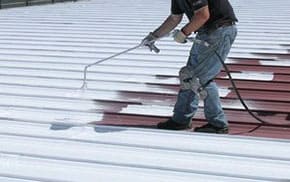
Liquid membrane is a thin coating which consists of usually a primer coat and two coats of top coats which are applied by spray, roller, or trowel. It offers more flexibility than the cementitious types of waterproofing.
The liquid cures into a rubbery coating on the wall. The elongation properties of the coating can reach as high as 280%. The durability of the waterproofing coating depends on what type of polymer the manufacturer use for the making of the liquid waterproofing.
Liquid waterproofing membrane can be of spray-applied liquid membrane composed of polymer-modified asphalt. Polyurethane liquid membranes in separate grades for trowel, roller, or spray are also available from various manufacturers.
Benefits of Liquid Waterproofing Membrane
Liquid waterproofing membrane have following benefits:
- Cost-effectiveness
- High performance
- Encapsulation
- Safety
- Easy Application
3. Bituminous Coating Waterproofing Method
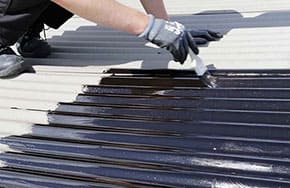
Bituminous Coatings are used to form a flexible and vapour proof protective coating, depending on the formulation and grade of polymerisation. With the grade of Polymer or Fibre Reinforcement used the grade of flexibility, behaviour against water and vapour transmission, etc. can be influenced. Typical application areas are under screed wet-are waterproofing, protective coating on concrete foundations, etc.
The flexibility of the finished products always depends on the solid content of the polymer added to the bitumen.
Bituminous coating is also called as asphalt coating. The most common applications of bituminous coatings include areas that are beneath screed wet. It is an excellent protective coating and waterproofing agent, especially on surfaces such as concrete foundations.
Properties of bituminous coating
Bituminous coating have following properties:
- Good adhesive properties
- Corrosion resistance
- Strong, waterproof, durable and economical
- Resists harsh chemicals and UV light
4. Bituminous Membrane Waterproofing Method
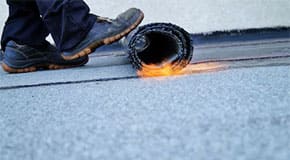
Bituminous membrane waterproofing is a popular method used for low-sloped roofs due to their proven performance. Bituminous waterproofing membrane have torch on membrane and self-adhesive membrane.
Self-adhesive compounds comprise asphalt, polymers and filler; additionally, certain resins and oils may be added to improve adhesion characteristics. The self-adhesive type has low shelf life as bonding properties of the membrane reduces with time.
Torch on membrane have exposed and covered types. Exposed membrane often has mineral granular aggregate to withstand the wear and tear of the weathering and the other types of membrane, contractor need to apply one protective screed to prevent the puncture of the membrane.
Features of Bituminous Membrane Waterproofing
Bituminous membrane waterproofing have following features:
- High puncture and fatigue resistance. Good heat resistance.
- Good dimensional stability under tension. High tensile and tear strengths.
- High chemical resistance.
- Excellent resistance to positive water and vapour pressure.
- Can accommodate structural movements because of excellent flexibility.
- Premium solution for Roof Waterproofing.
- These rolls are available in 3mm, 4mm & 5mm thickness.
5. Polyurethane Liquid Membrane Waterproofing Method
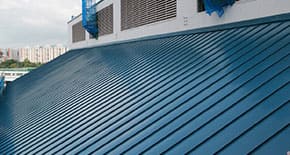
Polyurethane liquid membrane method of waterproofing is used for the flat roof area and exposed to weathering. This waterproofing method is expensive.
Polyurethane Liquid Membrane can offer higher flexibility. Polyurethane is very sensitive to moisture content present, therefore before application, one has to be very careful evaluating the moisture content of the concrete slab, otherwise peeling or de-bonding of membranes may happen after some time.
Applications of Polyurethane Waterproofing
Polyurethane waterproofing is used in the following type of structures:
- Roofs
- Balconies & Terraces
- Wet Areas
- Water Tanks / Ponds
- Pedestrian Decks
- Parking Decks / Bridges
- Detail Waterproofing
- Decorative Waterproofing
- Polyurethane Foamed Roofs

